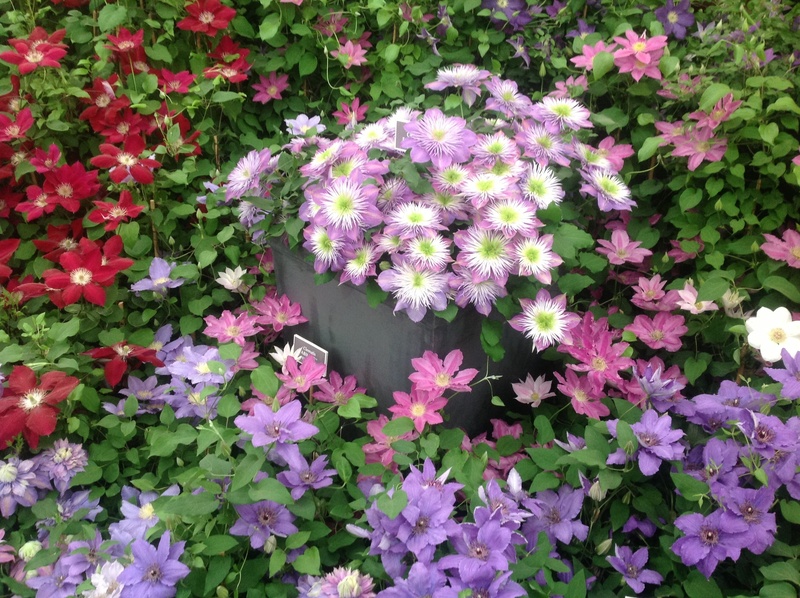Herb gardening for all seasons: strategies for year-round growth
Posted on 09/09/2025
Herb Gardening for All Seasons: Strategies for Year-Round Growth
Imagine stepping into your garden any time of the year and plucking fresh basil for pesto or sprigs of rosemary for your roast, regardless of the season. With strategic planning and the right techniques, herb gardening for all seasons can become your reality. In this comprehensive guide, we'll explore effective methods for cultivating herbs year-round, whether you have a backyard, a balcony, or even just a windowsill.
Understanding Herb Gardening: A Year-Round Perspective
Herbs are among the most versatile and rewarding plants you can grow. From culinary favorites like parsley and thyme to medicinal wonders such as echinacea and chamomile, they thrive in various environments and offer continuous harvests throughout the year with proper care. Adapting your approach for each season is key to successful all-season herb gardening.
Why Pursue Year-Round Herb Gardening?
- Fresh Flavors, Always: Enjoy the taste and aroma of just-picked herbs, even in winter.
- Cost-Effective: Growing your own reduces trips to the grocery store and saves money.
- Sustainable Living: Reduces reliance on commercially grown herbs that travel thousands of miles.
- Therapeutic Benefits: Gardening relieves stress and keeps you connected with nature.

Foundations for Successful Year-Round Herb Growth
Choosing the Right Location
Successful herb gardening for every season starts with location. Assess your available space, considering sunlight, temperature fluctuations, and protection from harsh weather.
- Outdoor Beds: Ideal for spring through early autumn in most climates.
- Containers and Pots: Offer flexibility, allowing you to move herbs indoors during cold weather.
- Indoor Herb Gardens: Essential for winter or for apartment dwellers. Use south-facing windows or supplemental grow lights for best results.
Selecting Herbs for Year-Round Gardening
Not all herbs perform equally well across seasons. Choose a mix of annuals, perennials, and cold-hardy varieties for continuous herb harvests throughout the year.
- Hardy Perennials:
- Thyme
- Sage
- Oregano
- Chives
- Mint (keep potted to avoid invasiveness)
- Annuals and Tender Perennials:
- Basil
- Cilantro
- Dill
- Parsley
- Cold-Hardy Choices:
- Parsley
- Chervil
- Cilantro
Season-by-Season Herb Gardening Strategies
Spring: Seed Sowing and Planting
Spring heralds the beginning of the active growing season. This is the prime time to plant most annual and perennial herbs outdoors.
- Direct Sow seeds of quick-growing herbs like cilantro, dill, and parsley as soon as the soil is workable.
- Transplant indoor-started herbs (basil, oregano, thyme) after the last frost.
- Perennial Pruning: Trim back winter-dormant perennials like sage and rosemary to encourage bushy growth.
- Amend the Soil: Mix in compost for a nutrient boost that supports robust herb growth.
Summer: Maintenance and Successive Sowing
Summer's warmth accelerates herb growth but also brings challenges like heat stress and bolting.
- Water Regularly: Herbs need consistent moisture; consider mulching to conserve water and maintain even soil temperature.
- Succession Planting: Every 3-4 weeks, sow new batches of short-lived herbs like cilantro and basil for ongoing harvests.
- Harvest Frequently: Regular snipping encourages bushier plants and prevents flowering, which can signal the end of leaf production.
Autumn: Extending the Season
As temperatures drop, thoughtful measures can prolong the growing season.
- Cold Frames/Row Covers: Protect tender herbs from early frosts and extend harvesting into late fall.
- Pot Up Herbs: Move container-grown or carefully dug-and-potted herbs indoors before the first hard frost.
- Prepare for Dormancy: Cut back perennial herbs, reduce watering, and cease fertilizing as they enter their rest period.
Winter: Indoor Herb Gardening and Overwintering
Herb gardening doesn't stop in winter! With a bit of creativity, you can maintain a lush indoor herb garden and keep perennials alive until spring.
- Grow Indoors: Set up pots in a bright window or under grow lights. Choose herbs like basil, parsley, thyme, and oregano.
- Utilize Hydroponics: Countertop hydroponic systems offer an incredibly efficient way to enjoy year-round herbs with minimal fuss.
- Care for Perennials: In colder climates, insulate outdoor perennials with mulch or straw, or bring pots inside a frost-free garage or basement.
- Monitor for Pests: Indoor herbs can attract aphids and mites. Inspect regularly and rinse leaves as needed.
Advanced Strategies for Year-Round Herb Gardening
Microclimates and Protection Techniques
Every garden contains microclimates--warmer or cooler spots that can be used strategically for all-season herb cultivation.
- South-Facing Walls: Plant herbs near these to take advantage of reflected heat in spring and autumn.
- Herb Spirals: These permaculture features provide varied conditions for different herbs, optimizing space and microclimates.
- Greenhouses: Even a small cold frame or hoophouse can allow continued outdoor growth throughout winter.
Soil and Fertility Management
Healthy soil underpins successful all-season herb gardening. Rotate annual herbs, add compost regularly, and avoid over-fertilizing, which can lead to weak, spindly growth.
- pH Preferences: Most herbs thrive in slightly alkaline soil (pH 6.5-7.5).
- Drainage: Ensure containers and beds drain well to prevent root rot.
- Organic Matter: Boosts soil structure and microbial health for robust plants all year.
Maintenance Tips for Year-Round Herb Health
- Regular Pruning: Maintains plant shape and encourages abundant leaves.
- Pest Monitoring: Especially important indoors; treat early with insecticidal soap or neem oil.
- Proper Lighting: Indoor herbs need at least 6-8 hours of bright light per day--supplement as necessary.
- Humidity Control: In winter, group pots or use a tray with pebbles and water to counteract dry air.
Harvesting and Preserving Herbs: Making the Most of Year-Round Growth
How to Harvest Herbs for Maximum Flavor and Yield
Frequent, light harvesting increases your yield and quality. For leafy herbs like basil and mint, pinch stems just above a set of leaves. Woody herbs--rosemary, thyme, sage--should be pruned gently, never taking more than one-third of the plant at once.
Preservation Methods for Abundant Herbal Harvests
When your plants produce more than you can use fresh, preserve the excess to enjoy homegrown flavor all year.
- Drying: Tie small bunches and hang in a cool, airy spot out of direct sunlight.
- Freezing: Chop herbs and pack into ice cube trays with a bit of water or olive oil for quick use in cooking.
- Infusing: Make herbal vinegars, oils, or syrups for both culinary and medicinal use.
Best Herbs for Year-Round Success
- Basil: Thrives indoors with good light; succession plant for continuous leaves in summer.
- Thyme: Perennial; durable in pots, beds, or window boxes.
- Rosemary: Needs winter protection in colder zones but can be overwintered indoors.
- Parsley: Biennial; cold-hardy, great for autumn and winter windowsill gardens.
- Mint: Grows vigorously indoors and outdoors; best kept in containers.
- Chives: Hardy perennial; offers mild onion flavor even in early spring and late fall.
- Oregano: Robust and easy to grow; tolerates drought and retains flavor when dried.
Common Challenges and Solutions for All-Season Herb Gardening
Dealing with Pests and Diseases
Herbs generally have natural pest resistance, but aphids, spider mites, and mildew can appear, especially in indoor environments.
- Aphids: Rinse under water or use insecticidal soap.
- Powdery Mildew: Improve air circulation and avoid overhead watering.
- Root Rot: Ensure proper drainage and avoid waterlogged soil.
Herb Bolting and How to Prevent It
Some herbs, particularly basil and cilantro, bolt (send up flowers) in hot weather, leading to bitter-tasting leaves. Harvest regularly, provide shade, and sow new seeds frequently in warm months for a steady supply.
Overwintering Perennials
- In-Ground: Mulch heavily after the ground freezes to insulate roots.
- In Containers: Move pots into protected spaces or cluster together for shared warmth.

Creative Ideas to Enhance Year-Round Herb Gardening
Vertical and Kitchen Herb Gardens
Maximize available space by growing herbs vertically -- wall-mounted planters, hanging baskets, or repurposed pallets. Place a mini-herb garden on your kitchen windowsill for easy access and year-round greenery.
Companion Planting
Combine herbs with vegetables and flowers to boost growth, repel pests, and create a diverse, resilient garden ecosystem. For example, plant basil with tomatoes or chives alongside carrots.
Conclusion: Embrace the Joy of Herb Gardening in Every Season
Herb gardening for every season empowers you to savor the rewards of fresh, flavorful, and aromatic herbs throughout the entire year. By understanding your climate, adapting your gardening methods, and leveraging strategies like indoor cultivation, succession planting, and smart preservation, you can harvest your own herbs whenever you desire. Let each season inspire your garden -- with thoughtful planning, resourcefulness, and a touch of creativity, a year-round herb harvest is well within your reach.
Start your journey today, and discover the endless possibilities and satisfaction that herb gardening for all seasons brings to your home, table, and well-being.

